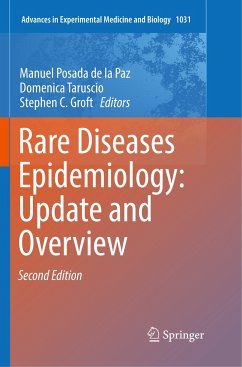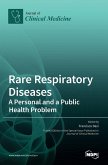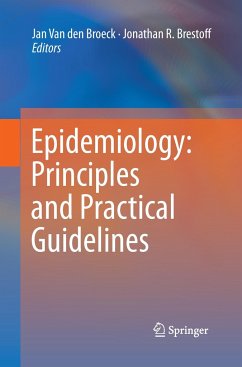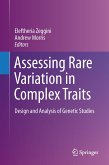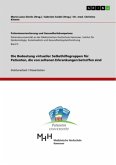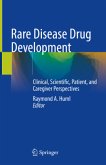Rare Diseases Epidemiology: Update and Overview
Herausgegeben:Posada de la Paz, Manuel; Taruscio, Domenica; Groft, Stephen C.
Rare Diseases Epidemiology: Update and Overview
Herausgegeben:Posada de la Paz, Manuel; Taruscio, Domenica; Groft, Stephen C.
- Broschiertes Buch
- Merkliste
- Auf die Merkliste
- Bewerten Bewerten
- Teilen
- Produkt teilen
- Produkterinnerung
- Produkterinnerung
The fields of rare diseases research and orphan products development continue to expand with more products in research and development status. In recent years, the role of the patient advocacy groups has evolved into a research partner with the academic research community and the bio-pharmaceutical industry. Unique approaches to research and development require epidemiological data not previously available to assist in protocol study design and patient recruitment for clinical trials required by regulatory agencies prior to approval for access by patents and practicing physicians.
Andere Kunden interessierten sich auch für
![Enhancing diagnostics and therapies for rare muscle diseases Enhancing diagnostics and therapies for rare muscle diseases]() Gerry S. MurrayEnhancing diagnostics and therapies for rare muscle diseases27,00 €
Gerry S. MurrayEnhancing diagnostics and therapies for rare muscle diseases27,00 €![Rare Respiratory Diseases Rare Respiratory Diseases]() Rare Respiratory Diseases78,99 €
Rare Respiratory Diseases78,99 €![Epidemiology: Principles and Practical Guidelines Epidemiology: Principles and Practical Guidelines]() Epidemiology: Principles and Practical Guidelines154,99 €
Epidemiology: Principles and Practical Guidelines154,99 €![Assessing Rare Variation in Complex Traits Assessing Rare Variation in Complex Traits]() Assessing Rare Variation in Complex Traits116,99 €
Assessing Rare Variation in Complex Traits116,99 €![Die Bedeutung virtueller Selbsthilfegruppen für Patienten, die von seltenen Erkrankungen betroffen sind Die Bedeutung virtueller Selbsthilfegruppen für Patienten, die von seltenen Erkrankungen betroffen sind]() Christine KlemmDie Bedeutung virtueller Selbsthilfegruppen für Patienten, die von seltenen Erkrankungen betroffen sind44,99 €
Christine KlemmDie Bedeutung virtueller Selbsthilfegruppen für Patienten, die von seltenen Erkrankungen betroffen sind44,99 €![The Ebola Crisis. An Overview The Ebola Crisis. An Overview]() Wasihun S. GutemaThe Ebola Crisis. An Overview27,95 €
Wasihun S. GutemaThe Ebola Crisis. An Overview27,95 €![Rare Disease Drug Development Rare Disease Drug Development]() Rare Disease Drug Development37,99 €
Rare Disease Drug Development37,99 €-
-
-
The fields of rare diseases research and orphan products development continue to expand with more products in research and development status. In recent years, the role of the patient advocacy groups has evolved into a research partner with the academic research community and the bio-pharmaceutical industry. Unique approaches to research and development require epidemiological data not previously available to assist in protocol study design and patient recruitment for clinical trials required by regulatory agencies prior to approval for access by patents and practicing physicians.
Produktdetails
- Produktdetails
- Advances in Experimental Medicine and Biology 1031
- Verlag: Springer / Springer International Publishing / Springer Science + Business Media B.V. / Springer, Be
- Artikelnr. des Verlages: 978-3-319-88385-4
- 2. Aufl.
- Seitenzahl: 704
- Erscheinungstermin: 9. September 2018
- Englisch
- Abmessung: 235mm x 155mm x 38mm
- Gewicht: 1062g
- ISBN-13: 9783319883854
- ISBN-10: 3319883852
- Artikelnr.: 55128267
- Herstellerkennzeichnung Die Herstellerinformationen sind derzeit nicht verfügbar.
- Advances in Experimental Medicine and Biology 1031
- Verlag: Springer / Springer International Publishing / Springer Science + Business Media B.V. / Springer, Be
- Artikelnr. des Verlages: 978-3-319-88385-4
- 2. Aufl.
- Seitenzahl: 704
- Erscheinungstermin: 9. September 2018
- Englisch
- Abmessung: 235mm x 155mm x 38mm
- Gewicht: 1062g
- ISBN-13: 9783319883854
- ISBN-10: 3319883852
- Artikelnr.: 55128267
- Herstellerkennzeichnung Die Herstellerinformationen sind derzeit nicht verfügbar.
Manuel Posada, MD, PhD (Please expand as you feel appropriate) is a specialist in Internal Medicine and in Public Health and Preventive Medicine. He has considerable expertise in areas such as multivariate analyses, medical statistics and research methodology. In his current position as Director of the Institute of Rare Diseases Research (IIER), Institute of Health Carlos III he leads a broad range of rare diseases activities in Spain in areas such as epidemiological and public health research. Dr. Posada is also the Director of the National Biobank on Rare Diseases (ISCIII) and the National Rare Diseases Registry. Dr. Posada is an Independent expert of the Commission Expert Group of Rare Diseases (CEGRD), European Commission and a member of the Advisory Board of the European Commission Platform Rare Diseases Registration. He is currently the President of the International Conference of Orphan Drugs and Rare Diseases (ICORD) Domenica Taruscio, M.D., is the Director of the Italian National Centre for Rare Diseases at the Italian National Institute of Health and of the National Rare Diseases Registry. She is a specialist in Histopathology and carried out post-doctoral studies in Human Genetics at Yale University (CT-USA) and in Bioethics. For decades, her efforts have been mainly directed to face the many and complex challenges posed by rare diseases and has addressed them from various facets: from science to society, from experimental research to public health, from training health professionals to the empowerment of patients and their families - having always at heart the quality of life of rare disease patients and of their families. Stephen C. Groft, Pharm.D. is currently a Senior Advisor to the Director, National Center for Advancing Translational Sciences at the NIH, USA. He assisted in establishing the Office of Orphan Products Development at FDA in 1982 and served as the Director of NIH's Office of Rare Diseases Research from 1993-2014 stimulating rare diseases research and developing information for patients, health care providers, research investigators, the biopharmaceutical industry, and the public about rare diseases, ongoing and completed research and clinical trials, and patient advocacy groups. Numerous initiatives were established in this role including the establishment of the Genetic and Rare Diseases Information Center, the International Rare Diseases Research Consortium the International Conference on Rare Diseases and Orphan Drugs, the Rare Diseases Clinical Research Network, assisted in the development of the Undiagnosed Diseases Program at NIH and the global Undiagnosed Diseases Network International, and developed common data elements for patient registries. ORDR co-sponsored numerous scientific conferences to assist in identifying research priorities and developing research agendas for the investigation of rare diseases.
Part I Introduction.- Rare Diseases: Joining Mainstream Research and Treatment Based on Reliable Epidemiological Data.- Part II Rare diseases diagnosis.- Undiagnosed diseases: Italy-US collaboration and international efforts to tackle rare and common diseases lacking a diagnosis.- Intellectual disability & rare disorders: A diagnostic challenge.- Improved diagnosis and care for rare diseases through implementation of a precision public health framework.- Part III Registries, Natural History of Rare Diseases and Biobanks.- Natural history, trial readiness and gene discovery: advances in patient registries for neuromuscular disease.- Facilitating Clinical Studies in Rare Diseases.- Rare Diseases Biospecimens and patient registries: Interoperability for research promotion, a European example: EuroBioBank and Spain RDR-BioNER.- Data Quality in Rare Diseases Registries.- Preparing data at the source to foster interoperability across r
are disease resources.- Part IV Orphan drugs and therapies.- Incentivizing orphan product development: United States Food and Drug Administration orphan incentive programs.- Post-approval Studies for Rare Disease Treatments and Orphan Drugs.- Evidence-Based Medicine and Rare Diseases.- Health technology assessment and appraisal of therapies for rare diseases.- New Therapeutic Uses for Existing Drugs.- Patient empowerment and involvement in research.- Part V Cost-Effectiveness and Cost-of-illness.- Cost-effectiveness methods and newborn screening assessment.- Cost-of-illness in rare diseases.- Part VI Rare Diseases Prevention.- Primary prevention of congenital anomalies: special focus on environmental chemicals and other toxicants, maternal health and health services and infectious diseases.- Newborn Screening: Beyond the Spot.- Part VII New Research Perspectives in RD.- A Global Approach to Rare Diseases Research and Orphan Products Development: The International Rare Diseases Research Consortium (IRDiRC).- Prospects of Pluripotent and Adult Stem Cells for Rare Diseases.- Personalized Medicine: What's in for Rare Diseases?.- Microphysiological systems (tissue chips) and their utility for rare disease research.- Part VIII Rare Diseases Epidemiology.- Epidemiology of Rare Lung Diseases: The Challenges and Opportunities to Improve Research and Knowledge.- Rare neurodegenerative diseases: clinical and genetic aspects.- Immunological rare diseases.- Indigenous Genetics and Rare Diseases: Harmony, Diversity and Equity.- Mortality Statistics and their Contribution to Improving Rare Diseases Epidemiology: the Example of Hereditary Ataxia in Europe.- Congenital Anomalies: Cluster detection and investigation.- Part IX Rare Diseases policies and society.- The European Union Policy in the Field of Rare Diseases.- The role of solidarity(-ies) in rare diseases research.- Bridging the gap between health and social care for rare diseases: key issues and innovative solutions.- Health systems sustainability and rare diseases.- Preparing for the Future of Rare Diseases.- Index.
are disease resources.- Part IV Orphan drugs and therapies.- Incentivizing orphan product development: United States Food and Drug Administration orphan incentive programs.- Post-approval Studies for Rare Disease Treatments and Orphan Drugs.- Evidence-Based Medicine and Rare Diseases.- Health technology assessment and appraisal of therapies for rare diseases.- New Therapeutic Uses for Existing Drugs.- Patient empowerment and involvement in research.- Part V Cost-Effectiveness and Cost-of-illness.- Cost-effectiveness methods and newborn screening assessment.- Cost-of-illness in rare diseases.- Part VI Rare Diseases Prevention.- Primary prevention of congenital anomalies: special focus on environmental chemicals and other toxicants, maternal health and health services and infectious diseases.- Newborn Screening: Beyond the Spot.- Part VII New Research Perspectives in RD.- A Global Approach to Rare Diseases Research and Orphan Products Development: The International Rare Diseases Research Consortium (IRDiRC).- Prospects of Pluripotent and Adult Stem Cells for Rare Diseases.- Personalized Medicine: What's in for Rare Diseases?.- Microphysiological systems (tissue chips) and their utility for rare disease research.- Part VIII Rare Diseases Epidemiology.- Epidemiology of Rare Lung Diseases: The Challenges and Opportunities to Improve Research and Knowledge.- Rare neurodegenerative diseases: clinical and genetic aspects.- Immunological rare diseases.- Indigenous Genetics and Rare Diseases: Harmony, Diversity and Equity.- Mortality Statistics and their Contribution to Improving Rare Diseases Epidemiology: the Example of Hereditary Ataxia in Europe.- Congenital Anomalies: Cluster detection and investigation.- Part IX Rare Diseases policies and society.- The European Union Policy in the Field of Rare Diseases.- The role of solidarity(-ies) in rare diseases research.- Bridging the gap between health and social care for rare diseases: key issues and innovative solutions.- Health systems sustainability and rare diseases.- Preparing for the Future of Rare Diseases.- Index.
Part I Introduction.- Rare Diseases: Joining Mainstream Research and Treatment Based on Reliable Epidemiological Data.- Part II Rare diseases diagnosis.- Undiagnosed diseases: Italy-US collaboration and international efforts to tackle rare and common diseases lacking a diagnosis.- Intellectual disability & rare disorders: A diagnostic challenge.- Improved diagnosis and care for rare diseases through implementation of a precision public health framework.- Part III Registries, Natural History of Rare Diseases and Biobanks.- Natural history, trial readiness and gene discovery: advances in patient registries for neuromuscular disease.- Facilitating Clinical Studies in Rare Diseases.- Rare Diseases Biospecimens and patient registries: Interoperability for research promotion, a European example: EuroBioBank and Spain RDR-BioNER.- Data Quality in Rare Diseases Registries.- Preparing data at the source to foster interoperability across r
are disease resources.- Part IV Orphan drugs and therapies.- Incentivizing orphan product development: United States Food and Drug Administration orphan incentive programs.- Post-approval Studies for Rare Disease Treatments and Orphan Drugs.- Evidence-Based Medicine and Rare Diseases.- Health technology assessment and appraisal of therapies for rare diseases.- New Therapeutic Uses for Existing Drugs.- Patient empowerment and involvement in research.- Part V Cost-Effectiveness and Cost-of-illness.- Cost-effectiveness methods and newborn screening assessment.- Cost-of-illness in rare diseases.- Part VI Rare Diseases Prevention.- Primary prevention of congenital anomalies: special focus on environmental chemicals and other toxicants, maternal health and health services and infectious diseases.- Newborn Screening: Beyond the Spot.- Part VII New Research Perspectives in RD.- A Global Approach to Rare Diseases Research and Orphan Products Development: The International Rare Diseases Research Consortium (IRDiRC).- Prospects of Pluripotent and Adult Stem Cells for Rare Diseases.- Personalized Medicine: What's in for Rare Diseases?.- Microphysiological systems (tissue chips) and their utility for rare disease research.- Part VIII Rare Diseases Epidemiology.- Epidemiology of Rare Lung Diseases: The Challenges and Opportunities to Improve Research and Knowledge.- Rare neurodegenerative diseases: clinical and genetic aspects.- Immunological rare diseases.- Indigenous Genetics and Rare Diseases: Harmony, Diversity and Equity.- Mortality Statistics and their Contribution to Improving Rare Diseases Epidemiology: the Example of Hereditary Ataxia in Europe.- Congenital Anomalies: Cluster detection and investigation.- Part IX Rare Diseases policies and society.- The European Union Policy in the Field of Rare Diseases.- The role of solidarity(-ies) in rare diseases research.- Bridging the gap between health and social care for rare diseases: key issues and innovative solutions.- Health systems sustainability and rare diseases.- Preparing for the Future of Rare Diseases.- Index.
are disease resources.- Part IV Orphan drugs and therapies.- Incentivizing orphan product development: United States Food and Drug Administration orphan incentive programs.- Post-approval Studies for Rare Disease Treatments and Orphan Drugs.- Evidence-Based Medicine and Rare Diseases.- Health technology assessment and appraisal of therapies for rare diseases.- New Therapeutic Uses for Existing Drugs.- Patient empowerment and involvement in research.- Part V Cost-Effectiveness and Cost-of-illness.- Cost-effectiveness methods and newborn screening assessment.- Cost-of-illness in rare diseases.- Part VI Rare Diseases Prevention.- Primary prevention of congenital anomalies: special focus on environmental chemicals and other toxicants, maternal health and health services and infectious diseases.- Newborn Screening: Beyond the Spot.- Part VII New Research Perspectives in RD.- A Global Approach to Rare Diseases Research and Orphan Products Development: The International Rare Diseases Research Consortium (IRDiRC).- Prospects of Pluripotent and Adult Stem Cells for Rare Diseases.- Personalized Medicine: What's in for Rare Diseases?.- Microphysiological systems (tissue chips) and their utility for rare disease research.- Part VIII Rare Diseases Epidemiology.- Epidemiology of Rare Lung Diseases: The Challenges and Opportunities to Improve Research and Knowledge.- Rare neurodegenerative diseases: clinical and genetic aspects.- Immunological rare diseases.- Indigenous Genetics and Rare Diseases: Harmony, Diversity and Equity.- Mortality Statistics and their Contribution to Improving Rare Diseases Epidemiology: the Example of Hereditary Ataxia in Europe.- Congenital Anomalies: Cluster detection and investigation.- Part IX Rare Diseases policies and society.- The European Union Policy in the Field of Rare Diseases.- The role of solidarity(-ies) in rare diseases research.- Bridging the gap between health and social care for rare diseases: key issues and innovative solutions.- Health systems sustainability and rare diseases.- Preparing for the Future of Rare Diseases.- Index.
"This second edition provides an update on the rapidly evolving field of rare disease research since the 2010 publication of the definitive first edition. ... The intended audience is clinicians, epidemiologists, and policymakers, as well as other professionals involved in rare diseases and research. The contributing authors are well versed in areas related to rare disease epidemiology, research, and health policy." (Victoria L. Crabb, Doody's Book Reviews, October, 2018)

